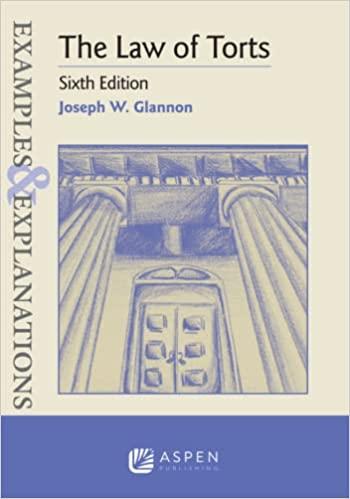Question
challenging busines law questions 15copies Appellants then moved for judgment n. o. v. or for a new trial, renewing their claims of antitrust immunity and
challenging busines law questions
15copies
Appellants then moved for judgment n. o. v. or for a new trial, renewing their claims of antitrust immunity and arguing that Northeastern had not presented sufficient evidence to support the verdict. Judge Eginton denied the motions, D.C., 497 F.Supp. 230, holding that except with respect to the evidence concerning SNET's pricing of key telephones, the jury had an ample basis upon which to predicate its findings of liability and damages. He then awarded Northeastern an additional $747,813.38 in attorneys' fees, as authorized by 15 U.S.C. 15. This appeal followed.
Northeastern does not challenge the legality of the invalidated tariff. It contends instead that the protective couplers were intentionally overdesigned, making them unnecessarily expensive and subject to break down. In particular, Northeastern complains that the couplers required an external power source[5]and that they had six-wire leads while Northeastern's PBXs were designed for two-wire interconnection. These features, Northeastern maintains, unreasonably hampered its efforts to compete in the business terminal equipment market.
Northeastern instituted the present suit in 1975, alleging that SNET, in violation of Section 2 of the Sherman Act, 15 U.S.C. 2, had monopolized and had attempted to monopolize the business terminal equipment market in Connecticut.[6]Appellee charged further that SNET, AT&T, and Western Electric had conspired to monopolize that market, also in violation of 2, and had conspired to restrain trade, in contravention of 1, 15 U.S.C. 1.
Question 1
Is there any role for heparin in management of septic shock?
Question 2
Is there more adrenaline (epinephrine) or noradrenaline (norepinephrine)
produced in shock? From where do these substances come from?
Question 3
I hear conflicting views as to whether activated protein C is useful in
shock.
Question 4
Why does both vasoconstriction and vasodilatation occur in shock?
Question 5
Are pulmonary artery (PA) catheters dangerous?
Question 6
In most hospitals, what is the difference between a high-dependency
unit (HDU) and an intensive care unit (ITU) and what is 'step down'
care?
Question 7
What is the difference between acute lung injury (ALI) and acute
respiratory distress syndrome (ARDS) from a practical point of view?
Question 8
What is the role of inhaled nitric oxide (NO) in acute respiratory distress
syndrome (ARDS)?
Question 9
What is meant by 'positive' pressure ventilation?
Question 10
Why is an electroencephalogram (EEG) not used in all countries to
evaluate possible brain death.
Step by Step Solution
There are 3 Steps involved in it
Step: 1

Get Instant Access to Expert-Tailored Solutions
See step-by-step solutions with expert insights and AI powered tools for academic success
Step: 2

Step: 3

Ace Your Homework with AI
Get the answers you need in no time with our AI-driven, step-by-step assistance
Get Started


